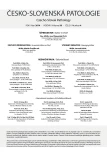Morphological and electrophysiological changes of the heart atria in necropsy patients with atrial fibrillation – a pilot study
Authors:
Adéla Matějková; Ivo Šteiner
Authors‘ workplace:
Fingerlandův ústav patologie LF UK a FN, Hradec Králové
Published in:
Čes.-slov. Patol., 50, 2014, No. 4, p. 150-154
Category:
Original Article
Overview
Atrial fibrillation (AF), the most common supraventricular tachycardia, has a morphological base, so called remodelation of atrial myocardium, with its abnormal conduction pattern as a consequence. The remodelation regards electrical, contractile, and structural properties. In this pilot study we attempted to find relations between the myocardial morphological (scarring, amyloidosis, left atrial enlargement) and electrophysiological (ECG characteristics of the P-wave) changes in patients with AF. We examined 40 hearts of necropsy patients – 20 with a history of AF and 20 with no history of AF. Grossly, the heart weight and the size of the left atrium (LA) were evaluated. Histologically, 7 standard sites from the atria were examined. In each specimen, the degree of myocardial scarring and of deposition of isolated atrial amyloid (IAA) were assessed. We failed to show any significant difference in the P-wave pattern between patients with and without AF. Morphologically, however, there were several differences – the patients with AF had significantly heavier hearts, larger left atria, more severely scarred myocardium of the LA and the atrial septum, and more severe deposition of IAA in both atria in comparison to the control group of patients with sinus rhythm. The left atrial distribution of both fibrosis and amyloidosis was irregular. In patients with AF the former was most pronounced in the LA ceiling while the latter in the LA anterior wall. The entire series showed more marked amyloidosis in the left than in the right atrium. An interesting finding was the universal absence of IAA in the sinoatrial node. The knowledge of distribution of atrial myocardial structural changes could be utilized by pathologists in taking specimens for histology and also by cardiologists in targeting the radiofrequency ablation therapy.
Keywords:
atrial fibrillation - isolated atrial amyloid - myocardial scarring - electrocardiographic features.
Sources
1. Lukl L. Fibrilace síní. Doporučené postupy pro praktické lékaře. Česká lékařská společnost JEP, www.cls.cz. 2001.
2. Piccini JP, Hammill BG, Sinner MF, et al. Incidence and prevalence of atrial fibrillation and associated mortality among medicare beneficiaries: 1993-2007. Circ Cardiovasc Qual Outcomes 2012; 5: 85-93.
3. Čihák R. Co nového přinášejí guidelines 2010 pro léčbu pacientů s fibrilací síní? Kardiol Rev 2010; 12(4): 187-191.
4. Haissaguerre M, Jaiss P, Shah DC, et al. Spontaneous initiation of atrial fibrillation by ectopic beats originating in the pulmonary veins. N Engl J Med 1998; 339: 659-666.
5. Eckstein J, Verheule S, de Groot N, Allessie M, Schotten U. Mechanisms of perpetuation of atrial fibrillation in chronically dilated atria. Prog Biophys Mol Biol 2008; 97: 435-451.
6. Allesie M, Ausma J, Schotten U. Electrical, contractile and structural remodeling during atrial fibrillation. Cardiovasc Res 2002; 12: 230-246.
7. Ausma J, Wijffels M, Thone F, Wouters L, Allessie M, Borgers M. Structural changes of atrial myocardium due to sustained atrial fibrillation in goat. Circulation 1997; 96: 3157-3163.
8. Röcken C, Peters B, Juenemann G, et al. Atrial amyloidosis: an arrhytmogenic substrate for persistent atrial fibrillation. Circulation 2002; 106: 2091-2097.
9. Šteiner I, Hájková P. Patterns of isolated atrial amyloid: A study of 100 hearts on autopsy. Cardiovasc Pathol 2006; 15: 287-290.
10. Pillarisetti J, Patel A, Boc K, et al. Evolution of paroxysmal atrial fibrillation to persistent or permanent atrial fibrillation: predictors of progression. J Atr Fibrillation 2009; 1(7): 388-394.
11. Cui Q, Zhang W, Wang H, et al. Left and right atrial size and the occurrence predictors in patients with paroxysmal atrial fibrillation. Int J Cardiol 2008; 130: 69-71.
12. Ariyarajah V, Steiner I, Hajkova P, et al. The association of atrial tachyarrhytmias with isolated atrial amyloid disease: preliminary observations in autopsied heart specimens. Cardiology 2009; 113: 132-137.
13. Westermark P, Johansson B, Natvig JB. Senile cardiac amyloidosis: evidence of two different amyloid substances in the ageing heart. Scand J Immunol 1979; 10: 303-308.
14. Šteiner I, Hájková P, Kvasnička J, Kholová I. Plicní žíly a fibrilace síní - studie 100 srdcí. Cesk Patol 2005; 41(4): 124-131.
15. Leone O, Boriani G, Chiappini B et al. Amyloid deposition as a cause of remodelling in persistent valvular atrial fibrillation. Eur Heart J 2004; 25: 1237-1241.
16. Kerr ChR, Humphries KH, Talajic M et al. Progression to chronic atrial fibrillation after the initial diagnosis of paroxysmal atrial fibrillation: Results from Canadian Registry of Atrial Fibrillation. Am Heart J 2005; 149(3): 489-496.
17. Marchese P, Bursi F, Donne GD, et al. Indexed left atrial volume predicts the recurrence of non-valvular atrial fibrillation after successful cardioversion. Eur J Echocardiogr 2011; 12: 214-221.
Labels
Anatomical pathology Forensic medical examiner ToxicologyArticle was published in
Czecho-Slovak Pathology

2014 Issue 4
Most read in this issue
- Current status of urinary cytology in the evaluation of bladder neoplasms
- Bart´s syndrome associated with epidermolysis bullosa junctionalis and with pyloric atresia. An autopsy case report
- International Society of Urological Pathology (ISUP) Vancouver Classification of Renal Neoplasia 2012
- A concise update on prostate pathology
